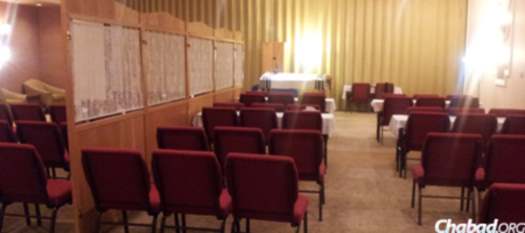
Congregation Makes the Most of an Unusual Venue
This was a real pickle, even for a Chabad rabbi.
How do you tell congregants that for the next year-and-a-half—while their new building was being constructed—that services, classes and events will be held in a different venue, an unusual venue, a … well, a funeral home?
As it so happens, Rabbi Dovid Flinkenstein, co-director of Chabad of Wilmette on Chicago’s North Shore, didn’t have to break the news. At their 20th-anniversary dinner in June 2012, the entertainment wound up relaying the plan. The rabbi had booked none other than a comedian, who got wind of the temporary location change and, suffice it to say, reeled off a few one-liners that night.
“He played it up,” acknowledges Flinkenstein. “But for the most part, people were not deterred. A Chassid makes his surroundings. This is what we had to transform”—a place associated with sadness into “a place of joy, of holiness, of celebration.”
And so, last fall, Chabad took its Torahs, ark and bimah, along with other accoutrements for services and programs, across the street to the Weinstein Funeral Home, where they set up shop in one of the home’s two chapels.
‘Neighbors Helping Each Other’
The Weinstein Funeral Home, a Dignity Memorial Provider, has served the 300,000-strong Jewish community of Chicago and its North Shore suburbs for 120 years. Since 1970, it has been located at 111 Skokie Blvd. in Wilmette, Ill.—a sprawling brick building with leafy surroundings—serving fourth and even fifth generations of families.
About 20 years ago, Flinkenstein moved Chabad into a small strip mall across the street. First, they rented space in two storefronts, alongside a dry-cleaners. In 2006, they purchased the entire strip. Last year they demolished it and began new construction.
“When you have a synagogue that opens across from you, you have an immediate relationship,” says Marshall Kayman, 76, who has worked at the funeral home for 14 years after a long career in clothing sales. “We quickly became neighbors helping each other out.”
Weinstein offered use of its sizable parking lot for Chabad attendees and encouraged the rabbi to set up the annual sukkah there as well. Chabad provided a convenient place for Weinstein staff to go for a service,kiddush,class or to lay tefillin.
Flinkenstein says “it was a perfect shidduch (match).”
When administrators at the funeral home heard Chabad had outgrown its current space and bought more storefront property to erect a brand-new building, they invited the rabbi to set up shop there.
“Look, we have two chapels,” Robert Sheck, 49, who has worked at Weinstein for 24 years, told the rabbi. “You can use one of them for Friday-night, Saturday and Sunday worship.”
Flinkenstein recalls the precise language: “ ‘Rabbi, it would be our pleasure to help you.’ ”
He still sounds in awe of the fact that the funeral home offered the space at no cost—and the larger of the two chapels at that. And the chapel had been recently renovated, with new carpet and chairs. “It was incredibly generous of them,” he states.
After consulting with the Chicago Rabbinical Council on certain matters ofhalachah (Jewish law), Flinkenstein accepted the offer. Many of his constituents could continue to walk to shul, and anyone who visited would inevitably note the progress being made on the new facility: a “win-win.”
‘A Tricky Adventure’
But first, some issues had to be ironed out.
There was security—how to get into the chapel over Shabbat. Fortuitously, non-Jewish mortuary students let worshippers into the building and help out in other ways. More complicated was how a Kohen (priest) would pray, as they are forbidden to come in contact with, be under the same roof as, or at times even be in the same building with a dead body. That problem was structurally solved: The chapels were technically separate buildings with separate roofs and entrances, so Kohenim could enter one chapel regardless of what was happening in the other.
And then came the Friday dilemma, when both chapels were often used during the day for funeral services, comprising a completely different setup than the evening one for Chabad. Once the mourners left, the rabbi and Weinstein staff would rearrange the chairs, and put up the mechitzah, aron kodesh andother necessities—a “tricky adventure,” according to Kayman.
Finally, they had to contend with another potential obstacle: getting folks past the idea of entering a funeral home on Shabbat and Jewish holidays.
“There is a sadness to it,” concedes Sheck, “but it’s also a celebration of an individual’s life. It’s thinking outside of the box, and Chabad has taught us that—to think outside of the box.”
Brenda Goffen, who has been coming to Chabad with her husband for five years now, agrees. “A funeral home is a sacred space. Many of us have had to lay to rest friends and family there, but that’s part of life. So it didn’t feel so unusual.”
What did feel different was something else entirely: “Is there any place in the world where you could walk into a funeral home and smell the cholentbubbling?”
Goffen, a mother of two and grandmother of three, calls themselves “regulars.” She says when she first started attending, she knew two people; now she knows practically everyone.
“I’m 72 and coming to this later in life, but it’s been beautiful for us, really like a family.”
She specifically notes this year’s Simchat Torah celebration, dancing in and out of the funeral home, watching the children somersault across the floor, and running up and down the stairs to the basement getting all the food together. Chabad has “so much soul,” she stresses.
Peter and Nancy Kaufman enrolled their daughter, Julia, in Chabad’s Hebrew school when she entered first grade. She became a bat mitzvah last year, with akiddush sponsored at the storefront site in her honor.
As for the current situation, Nancy notes that “it might seem a little odd on the surface, but it’s across the street and they needed the space.”
Peter adds, “If you didn’t know it was a funeral home, you’d think it was a synagogue. There are plain colors, with a plain design and fabrics. It’s like a blank palette. The ark is there, the bimah; all the trappings from across the street are in there, and they are familiar.
“I think it was serendipitous, a mitzvah. The stars came into alignment. The rabbi has had this vision as long as we’ve known him, and now he’s able to build it. The fact that the funeral home was able to open its doors in the meantime … it opened its doors to life.”
Flinkenstein, who has run Chabad of Wilmette for 21 years with his wife, Rivke, says Weinstein even allowed them use of an entire office suite in its basement.
As appreciative as the rabbi is, he looks forward to the new building’s completion, slated for March. Chabad is about $300,000 away from the total project’s cost of between $2.5 and $3 million.
He says the space will have a real presence, from Jerusalem stone and a sleek exterior to 18-foot ceilings and two-dozen stained-glass windows inside, “each on a theme central to Judaism and that leads to action. It will be an inspiring place for every Jew, a warm and welcoming place.”
Flinkenstein’s daughter and son-in-law, Rabbi Moshe and Esther Leah Teldon, arrived this summer to lead youth programming and help jump-start a roster of activities: “While the concrete is being poured, we’re working on the inner foundation, the life and soul of the Chabad center.”
Kayman remains “thoroughly amazed at how well it’s all come about.”
“We feel we can only grow from this relationship,” says the Weinstein representative. “And we hope it will continue for many, many years.”














Better sooner than later
Good reason to attend the Chabad minyan. Sooner or later all end up at the chapel. Better sooner, while thank g-d alive. and sitting in a chair, than later in a box.
What about a cohen?
If there is a dead person under the same roof
Milhouse
Why don’t you try reading the article before commenting?
Milhouse says they did bdikas meisim
before a cohen enters thay must do bedikas meisim to insure that no corpses are left behind.
Milhouse
Just read the ^&%# article, and you won’t make a fool of yourself. No bedikah is necessary.
Bedika is needed
To make sure no corpses are around. In a pinch. the chapel would be used and a body or body part can be left behind.
We do bedikas chometz “just in case”, they need to do bedikas meisim “just in case”!
Milhouse
Amhoratzus. You’re just making it up as you go along. There is no such requirement found anywhere in halacha, and you can’t just make it up yourself. So long as there is not known to be a body in that building, why should we be concerned?
Whenever there is an issur we need a bedika
Haven’t you heard of bedikas to’loim (insects)?
When there is issur, you must make a bedika to acertain it is now muttar.
Ditto in chapel, a bedikas meis is required.
Milhouse
Garbage. There is no such requirement. You are simply pulling things out of your behind.
The chapel had a meis, the meis is now gone, end of story. It had 20 meisim, or 100, and they’ve all been removed, one at a time. There’s no need to speculate that maybe there’s another one hiding somewhere!
B. Sholom Wolf
Cute irony. Seems like a beautiful project for two well deserved shluchim. May the Flinkensteins enjoy much hatzlocho and looking forward to see finished project one day.
reminds me of...
A guy in a taxi wanted to speak to the driver so he leaned forward and tapped him on the shoulder. The driver screamed, jumped up in the air and yanked the wheel over. The car mounted the curb, demolished a lamppost and came to a stop inches from a shop window.
The startled passenger said “I didn’t mean to frighten you, I just wanted to ask you something.”
The taxi driver says “It’s not your fault sir. It’s my first day as a cab driver…
I’ve been driving a hearse for the past 25 years
#2 Cohen
There are serious halachik problems with a Cohen entering that building.
Milhouse
No, there are not. Read the #@%^ article, for Heaven’s sake!
Milhouse paskens from an article
A meis is metameh an ohel. Everything in the ohel is tomeih. Every child knows that. A cohen cannot enter – even if the meis was removed. All the chairs and keilim are tomeih meis. That is what it says in chumish, but Milhouse has his own psak from the article.
Ezra
#9, that is absolutely, 100%, totally wrong. It is true that the chairs, etc., become tamei, but that doesn’t prevent a kohen from touching them or being in the same room as them. See Yoreh De’ah 369:1 in Rema.
Besides, though, simple logic would explode your theory. Since we have no parah adumah nowadays, any object that becomes tamei meis stays tamei forever. Have you ever heard of a kohen checking whether a particular chair was in an ohel hameis before sitting on it, or whether a particular building at any time in its history had a dead body in it, etc.?
Milhouse
Utter amhoratzus! A kohen (even one who is already tomei) is forbidden to become tomei directly from a meis, either by direct contact or by ohel. There is no issur at all on his becoming tomei from someone who touched a meis. He is 100% permitted to shake hands with the chevra kadisha people as they come out from doing a tahara. And he is certainly allowed to enter an ohel where a meis used to be, and to touch anything that is still there.
Like dishes that had forbidden foods...
A meis to a cohen is like treif food.
Treif food effect the dishes, and make them non-kosher.
A meis effects the area and vessel therein and makes them tomei.
I wouldn’t shake hands with someone who just woke up and didn’t wash negel vasser. I wouldn’t shake hands with someone who left a cemetery before he washes his hands.
Reason: the tuma is on their hands!
And I am not even a cohen!!!
Kal v’chomer a cohen shouldn’t!!!
Milhouse calls this “utter amhoratzus” but I say this is Alef Bais basics!
if it is in a vessel, the vessel becom
Milhouse
The first rule of holes is that when you’re in one, stop digging! You’re just exposing your amhoratzus more and more. There is no such halacha. You are making up your own dinim, and you have no right to do so. I don’t care what you “wouldn’t” do; all these things that you say you wouldn’t do are perfectly fine, and nobody else has to adopt your mishugassen. Let alone make kal vachomers from them!
Milhouse
PS: The mishneh says אין בור ירא חטא ולא עם הארץ חסיד. This is why. If you’re up to “alef beis basics” don’t try to pasken dinim for yourself, let alone for others!
For your information, sleeping does not cause tum’ah, and washing the hands doesn’t remove it. Nor is someone who came from a cemetery any more tomei before he washes his hands than after. Hand-washing does not remove tum’ah (except the special “tum’ah” that Chazal decreed on stam hands, in order to encourage hand-washing for cleanliness). Negel vasser is not because of tum’ah, al pi din it’s simply for cleanliness, and al pi nistar it’s for a mysterious רוח רעה. This רוח רעה is not transferred to another person, so there’s no reason not to shake the hand of someone who has it.
Food touched without negel vasser
Milhouse is wrong, as usual. It is forbidden to eat food touched by someone who did not was negel vasser. the tumah is transferred to the food! Many hashgochas insist that food workers (of course – the jewish ones) MUST wash negel vasser before handeling the food.
And according to Milhouse the reason for hand washing after leaving a cemetary is…??? (notice how he avoided this point entirely!)
Milhouse
What an am ho’oretz. I advised you to stop digging; you should have listened. The issue in both cases is רוח רעה, and has nothing at all to do with tum’ah. In fact washing for רוח רעה when leaving a cemetery is only a yesh omrim; so it’s even less than when waking up.
Me’ikar hadin, i.e. al pi nigleh, there is no issue at all, in either case. Washing when waking up is only for cleanliness, and there is no requirement at all to wash when leaving a cemetery.
bracha
I give a bracha and bakasha that this should be the start of the living being the only need for such a place. This is, not to be cliche at all….Moshiachdik.
This is the bracha
Mechaya Ha’Mesim
Anonymous
“Is there any place in the world where you could walk into a funeral home and smell the cholent bubbling?”
Well,at least, at Techays HaMeisim the arisen people will have something to eat
Shmuley
I grew-up in a Jewish Funeral Home in the South.
Just to clear-up a small matter, a building that is purposely built for the use of funeral service professionals is called a “mortuary”. An existing residence that has been converted into a building for funeral service professionals to operate in is called a funeral “home”. Unfortunately there are less and less funeral homes as the existing ones become too small for a growing business. Most old funeral homes have a residence, either a back area of the building or the upstairs floor,etc. We had a three bedroom apartment upstairs. There were plenty of times you could walk in the front door of the funeral home to be greeted by the smell of some wonderful food cooking. There were plenty of times grandma would make fresh cinnamon rolls or bialys to send downstairs to families making arrangements along with good fresh coffee and/or hot chocolate. So when I read this story of kindness by the Weinstein folks, it reminded me of when our old place enjoyed the perfume of a cholent in the oven. There can be a lot of living in a house of the dead.